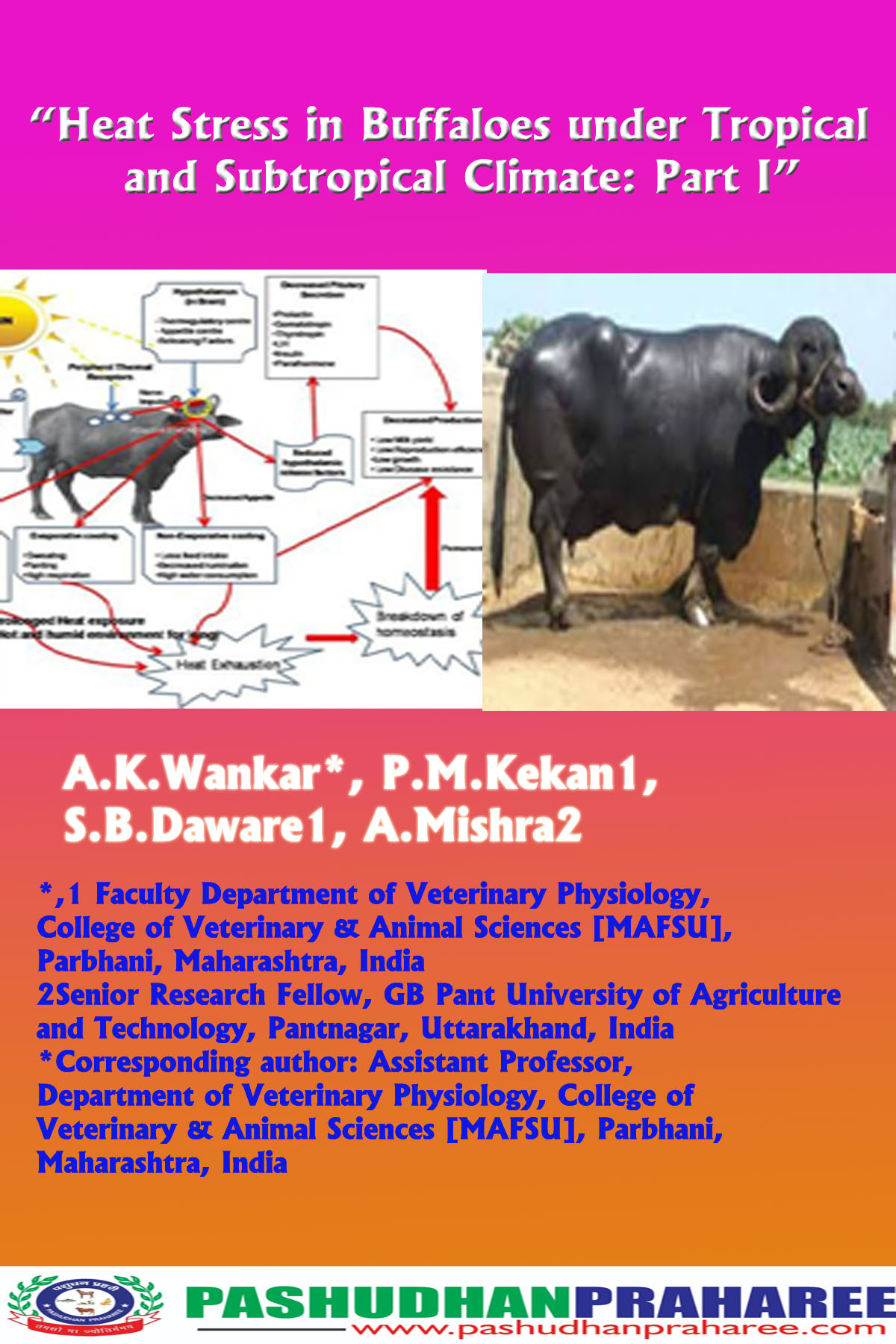Heat stress in buffaloes under tropical and subtropical climate: Part I
A.K.Wankar*, P.M.Kekan1, S.B.Daware1, A.Mishra2
*,1 Faculty Department of Veterinary Physiology, College of Veterinary & Animal Sciences [MAFSU], Parbhani, Maharashtra, India
2Senior Research Fellow, GB Pant University of Agriculture and Technology, Pantnagar, Uttarakhand, India
*Corresponding author: Assistant Professor, Department of Veterinary Physiology, College of Veterinary & Animal Sciences [MAFSU], Parbhani, Maharashtra, India
Email ID: wankaralok@covaspbn.co.in, wankaralok@gmail.com
With the advent of increasing human population, the food industry will have to keep pace to supply. The current climate change scenario is already a major constraint on production sector. Several international agencies have predicted a 0.5 to 4.5°C rise in environmental temperatures by the end of 21st century. The adverse climatic conditions will challenge the animal welfare and production in turn. High ambient temperatures, humidity, solar radiations or THI all activate different thermoregulatory responses in livestock, thereby negatively affecting growth, welfare and production. The environmental conditions are always more extreme in tropical and subtropical regions. This pushes the species there, to make different adjustments to maintain normal body temperature i.e. thermoregulation. Although, essential thermoregulation alters the normal physiology and metabolism of animals and less energy is made available for other processes, reducing the total production. Already the negative impact of global warming is evident throughout the world and significant economic losses are borne each year by both developed and developing nations.
WHY BUFFALOE IS MORE SUCCEPTIBLE TO HEAT STRESS
The buffalo is mainly distributed in Asia, Africa and some European countries. The climate in Asia and Africa is categorised as tropical to subtropical. The buffalo is comfortably adapted to these hot-humid environmental conditions, but its phenotypic characteristic’s make it more vulnerable to sustained high temperatures, humidity, direct solar radiations and THI, as compared to cattle.
Its naturally black skin color absorbs more solar radiations and heats up quickly. Lack of hair or sparse hair coat significantly increase the penetration of solar radiations and heat in buffaloes, as compared to cattle which have dense reflective hair coats. The evaporative cooling via sweating is also meagre in buffaloes as the have very less sweat glands (only 1/6) as compared to cattle (Mullick, 1964). All these factors facilitate heat gain in buffaloes, easily and predisposes it to heat stress.
There are few mechanisms present in buffaloes to combat heat stress like, tough keratinized epidermal skin layer having abundant melanin pigment. Also the sebaceous glands are very well developed, which secrete greasy sebum which melts and spread under direct sun, protecting the buffalo from direct sun rays. The main ameliorative measure against heat stress in buffaloes, is wallowing. Wallowing carries away the excess heat and cools off the animal. Another minor mechanism for evaporative cooling is panting. For evaporative cooling mechanism (panting) or wallowing large volumes of water are required which can be a primary constraint for animal welfare in dry tropical and subtropical regions.
HEAT STRESS MECHANISM
When the balance between heat generated or gained is greater than heat dissipated, organism accumulates excess heat. Conduction, convection and radiation are the major means of heat dissipation. These mechanisms work efficiently, till the surrounding temperature is lower than core body temperature. High environmental temperature, humidity, solar flares, heat waves and THI shift the thermoregulatory balance and animals start gaining excess heat. Thereafter, heat loss is mainly by evaporative cooling which includes salivating, panting and sweating. But the evaporative cooling mechanisms are energy consuming and cannot be continued for longer duration, for example persistent panting increases the maintenance energy, generates additional metabolic heat and consumes significant energy. Livestock from tropics and sub-tropics are exposed to high temperatures and humidity or their combination (THI) for major part of the year. Although well adapted to harsh conditions acute or chronic thermal stress, gradually compromise the heat dissipation ability of animals and productive or reproductive functions are negatively affected.
There are many indices to measure heat stress in animals and THI is most commonly used to assess the severity of heat stress. The five major categories of THI are as follows; stress free (THI ˂ 72), mild stress (72-78), moderate stress (79-88), severe stress (89-98) and fatal stress at THI above 98 (Armstrong, 1994). Recent technology like automatic weather stations, artificial intelligence, wearable devices and gadgets and cloud based applications have made the heat stress monitoring very convenient improving our understanding of climate x animal interaction, which affects the animal welfare, growth, production and reproduction indices.
To be continued in part II……..
REFERENCES
Armstrong, D.V. (1994). Heat stress interactions with shade
and cooling. Journal of Dairy Science, 77: 2044-2050.
Mullick, D.N. (1964) Reviews of the investigations on the physiology of Indian buffaloes. Indian Journal of Dairy Science, 17: 45-48.


